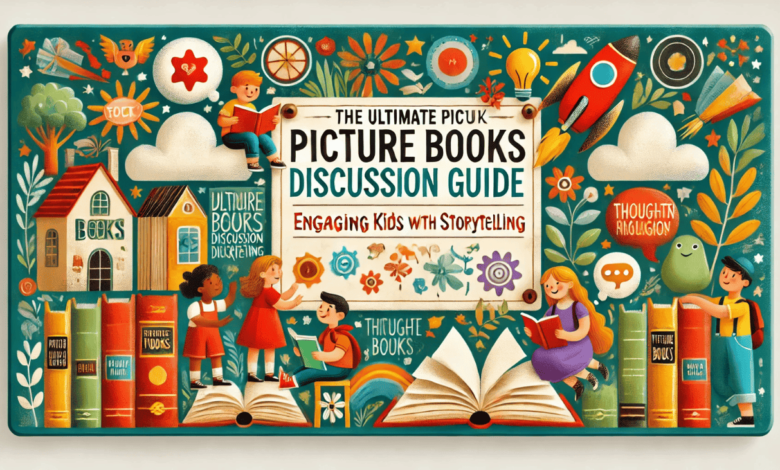The Ultimate Picture Books Discussion Guide: Engaging Kids Through Storytelling

Picture books hold a special place in children’s literature. They captivate young minds with vibrant illustrations and engaging stories while subtly conveying important life lessons. Whether you’re a parent, teacher, or caregiver, using a picture books discussion guide can help make reading sessions more meaningful. These guides encourage critical thinking, spark conversations, and deepen a child’s understanding of the world. In this article, we will explore the benefits of picture book discussions, how to structure them, and provide recommendations for must-read books with discussion points.
Why Use a Picture Books Discussion Guide?
Encourages Critical Thinking
Reading a picture book is more than just a visual experience. A picture books discussion guide prompts children to think beyond the surface of the story, analyze characters’ motivations, and predict outcomes. This nurtures their ability to evaluate situations and develop reasoning skills.
Builds Emotional Intelligence
Picture books often explore themes like empathy, kindness, and resilience. A picture books discussion guide allows children to relate to characters’ emotions and reflect on their own feelings. Talking about challenges faced by the characters helps children process their emotions in a safe and supportive environment.
Enhances Language and Literacy Skills
Guided discussions encourage children to articulate their thoughts, expand their vocabulary, and improve comprehension. By asking open-ended questions and encouraging storytelling, you can help young readers strengthen their communication skills.
Promotes a Love for Reading
A well-structured discussion can transform reading from a passive activity into an engaging experience. When children are encouraged to share their thoughts and ask questions, they develop a deeper connection to books, making them more likely to become lifelong readers.
How to Structure a Picture Books Discussion Guide
Creating an effective picture books discussion guide requires a thoughtful approach. Here’s how you can structure a meaningful discussion:
Pre-Reading Questions
Before diving into the book, set the stage with a few engaging questions:
- What do you think this book might be about based on the cover illustration?
- Have you ever read a book by this author before?
- What do the title and pictures tell us about the story?
During-Reading Questions
As you read, pause occasionally to ask questions that encourage children to make predictions and connections:
- What do you think will happen next?
- How do you think the character is feeling right now?
- Have you ever been in a similar situation?
Post-Reading Discussion
After finishing the book, reflect on the story with deeper questions:
- What was your favorite part of the story and why?
- What lesson did the characters learn?
- If you could change one thing about the story, what would it be?
- How would you describe this book to a friend?
Recommended Picture Books with Discussion Points
Here are five powerful picture books along with discussion prompts to help guide meaningful conversations:
The Invisible Boy by Trudy Ludwig
Themes: Inclusion, kindness, empathy
Discussion Questions:
- How did Brian feel when no one noticed him?
- What did the new student do to help Brian feel included?
- How can we make sure no one feels invisible in our classroom or community?
Last Stop on Market Street by Matt de la Peña
Themes: Gratitude, diversity, perspective
Discussion Questions:
- What do you think CJ learned from his grandmother during their bus ride?
- Why do you think the grandmother sees beauty in things CJ initially complains about?
- How can we learn to appreciate the little things in life?
The Day the Crayons Quit by Drew Daywalt
Themes: Creativity, self-expression, perspective-taking
Discussion Questions:
- Why were the crayons unhappy?
- How would you feel if you were one of the crayons?
- If you could add a new crayon color to the box, what would it be and why?
Sulwe by Lupita Nyong’o
Themes: Self-esteem, beauty, self-acceptance
Discussion Questions:
- Why did Sulwe feel different from her peers?
- What message did the story convey about beauty?
- How can we help others feel confident about themselves?
I Am Enough by Grace Byers
Themes: Self-worth, kindness, empowerment
Discussion Questions:
- What does it mean to be “enough”?
- How can we show kindness to ourselves and others?
- What is something you love about yourself?
Frequently Asked Questions (FAQs)
What is a picture books discussion guide?
A picture books discussion guide is a structured set of questions and activities designed to help children engage more deeply with a story. It encourages critical thinking, comprehension, and emotional connections to the themes presented in the book.
How can I create my own picture books discussion guide?
To create your own picture books discussion guide, focus on three key areas: pre-reading (questions about the cover and title), during-reading (predictive and analytical questions), and post-reading (reflection and application questions). Choose questions that align with the book’s themes and the child’s comprehension level.
What are some good picture books for discussion?
Some excellent books include The Invisible Boy, Last Stop on Market Street, The Day the Crayons Quit, Sulwe, and I Am Enough. Each of these books offers meaningful themes that encourage engaging discussions.
How can picture book discussions improve a child’s literacy skills?
Discussions encourage children to think critically, articulate their thoughts, and expand their vocabulary. By asking thought-provoking questions, children develop stronger reading comprehension and storytelling skills.
How often should I use a discussion guide?
You can use a picture books discussion guide as often as you like. Whether it’s once a week or every time you read a book together, guided discussions help children connect with stories on a deeper level.
Conclusion
A picture books discussion guide is a valuable tool that transforms reading into an enriching experience. By asking thoughtful questions and engaging children in meaningful discussions, we can help them develop empathy, critical thinking, and a love for storytelling. Whether at home or in the classroom, using discussion guides makes story time more interactive and impactful. Try incorporating these strategies and books into your reading routine, and watch how they inspire deeper conversations and connections.
Encourage children to express their thoughts, explore their imaginations, and develop a lifelong appreciation for books. Happy reading!



